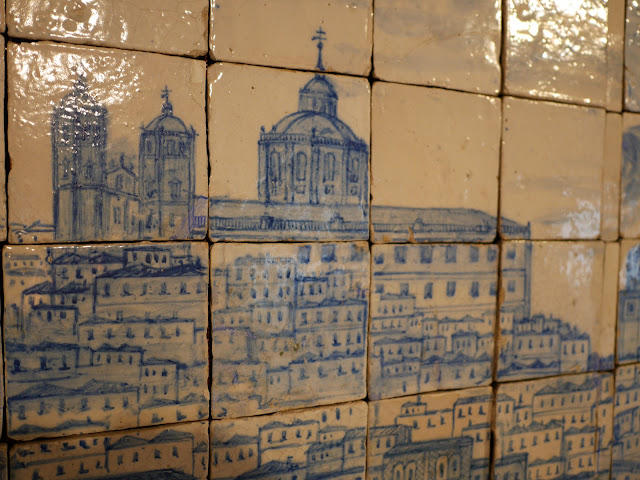Iberia's tiles are everywhere. The peninsula is one big Scrabble board. I have been photographing these ceramic squares, or azulejos, during my time in Lisbon.
Why then, if Portugal is a veritable outdoor tile museum, should one visit the Museo Nacional do Azulejo? To that question, I got nothin'. But if you walk there, you'll get a good look at the docks and adjoining train tracks. Even more enticing: The former convent in which the museum is housed is open and bright, cool and quiet, and has a nice gift shop.
In 1500s Europe, Islamic knotwork and geometric motifs were gradually replaced by plant and animal themes, but repetitive tile patterns continued to be a great solution for churches that needed to cover entire interior walls. You could tuck small religious scenes into them.
The convent's Manueline cloister is below. The museum is housed in the monastic buildings of the Church of Madre-de-Deus.
Space heaters chug away in every room but are no match for the city's late-autumn temps.
A flower vase with cherubs and parrots from the former convent of Nossa Senhora da Esperanca in Lisbon from the 17th century.
"The Chicken's Wedding," artist unknown, from the 1660s. Followed by some details.
Modern master Querubim Lapa, who died in 2016, produced these azulejos for a Lisbon kitchen. The nation's cultural heritage ministry smartly acquired them in 2022.
There has been an explosion of interest in Portuguese ceramic art in the last 50 years, and many of the country's most prestigious artists have embraced the medium.
Don't leave before seeing the Great Lisbon Panorama depicting the city before the earthquake in 1755. It is some 75 feet long and made up of 1,384 tiles.
In the convent's courtyard, a rose garden still thrives three weeks before winter's onset. It's quite cool but not cold. I think the last time it snowed was 2006.
A couple of blocks to the east there is quirky street art as well as some rustic tascas with really cheap food and beer. If you are still hungry for contemporary azulejos, ride the metro.






































Comments
Post a Comment